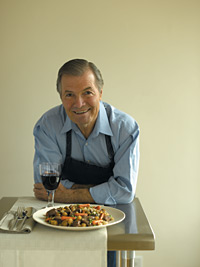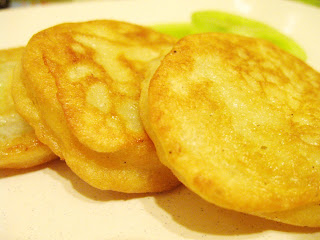To love something, you have to understand it. You cannot be a foodie without a profound appreciation for how food is grown or raised, what was done to it before transportation, where it came from, and what myriad of factors made it possible for it to reach your table.
Journalist and author,
Michael Pollan, has written two best-selling treatises on our complicated relationship with the things we eat: "
The Omnivore's Dilemma" and "
In Defense of Food". He has articulated the guilt, confusion and desires that direct our diet in Western society. We suddenly find ourselves trapped in a situation where "what's for dinner?" becomes a minefield of ethical,
socio-economic and biochemical issues.
Organic, pesticide-free, free-run, free-range, gluten-free, lactose-free, peanut-free, trans-fat free, monounsaturated fats, non-fat, low sodium, low
carb, low cholesterol, omega-3, vitamin-enriched, calcium-enriched, unbleached, baked instead of fried, vegetarian instead of carnivore, vegan instead of vegetarian, heirloom or hybrid, processed or fresh, wild or farmed, local or imported, and on and on and on it goes.
The innocence of a simple peanut butter and jelly sandwich on white toast is long gone. The peanut spread could potentially kill someone with nut allergies. If the peanut butter isn't organic, then it may have been made with "bad" fats to keep the natural oils from separating. The jelly might have been made from fruit that was exposed to pesticides and sweetened with white refined sugar. The white bread was made from bleached flour. Blackened edges of the toast may introduce carcinogens into your system. The fuel expended to truck the jelly from a factory across the border may have contributed to global warming and skyrocketing gas prices. If you're not killing yourself with your dietary choices, then you're killing the planet.
Foodies
are to blame for certain excesses and practices that are questionable, at best. They have a taste for exotic ingredients like pink Himalayan salt that need to be shipped at great expense from far-flung places. They help drive up food prices by insisting on consuming at the same rate, regardless of whether resources are scarce or plentiful. The lust for
foie gras perpetuates the controversial practice of
gavage -- the force-feeding of ducks and geese to fatten up their livers -- which has been described as "harmless", "cruel" and everything in between. To produce a pound of the pricey and much-revered saffron, 50,000 to 75,000 saffron crocus flowers need to be harvested; yet its role in cuisine is only to impart color and aroma to dishes -- its taste is nothing to write home about.
I conveniently switched to the third-person "they" in the last paragraph, but I am in fact a member of this epicurean clique. I eat meat.
Foie gras is absolutely delicious. There are four types of salt in my pantry, and not one of them is the cheap, iodized kind. I allow myself to splurge on exceptional cuts of meat from time to time. Gorgeous olive oils imported from Italy make my eyes sparkle.
Sometimes all this extravagance and preciousness seems all for naught. Once, I ventured to buy a fragment of the extremely rare
white truffle from
Pusateri's to make a white and black truffle risotto dish for friends. The store manager was obliged to personally escort me and my truffle -- gently nestled on a bed of tissue paper in a box -- to the cash. The gum-popping cashier was impressed by the drama, but had never heard of my little "diamond of the kitchen" (quoting Jean
Anthelme Brillat-
Savarin). I explained that it was revered for its intense aroma and offered her a whiff. I might as well have farted in her face.
The risotto was elaborately prepared over days and the final result was to die for, if I may say so myself. Can I justify it? I'm not sure. But I would do it again.
For one thing, the fussiness and endless appetites of foodies create the demand for organic, sustainable, local farming. Produce tastes better when grown without the tampering of synthetic chemicals. Shorter distances between farms and customers make it possible to deliver food that is still vibrantly fresh while leaving a smaller energy footprint. Meat is more tender and nutritious when it comes from a happy animal that has been scampering around in the sun and fattened up on a good quality diet. Eggs that come from free-run chickens are bigger, and when you
crack'em, the yolk is bright, firm and bulging with goodness.
Nose-to-tail eating is the practice of using every last piece of an animal slaughtered for consumption. This is a practical, ancient approach that dates back to our hunter-gatherer days, but it had fallen out of favor in modern times with the Chicken
McNugget crowd. Celebrated chef Fergus Henderson of the
St. John Restaurant in London, chef Martin
Picard of
Restaurant Au Pied de Cochon in Montreal, and writer/farmer/activist
Hugh Fearnley-Whittingstall of the
River Cottage in Dorset are just some of the high profile gastronomes who have been re-introducing the world to all the
other edible animal parts like ears, tails, feet, tripe, sweetbreads, and cheeks. These movers and shakers have a healthy respect for all creatures that makes them loathe to let the sacrifice of an animal go to waste.
In the end, I think what matters is to always have an awareness of what you are eating. The title of William S.
Burrough's novel, "
Naked Lunch", refers to "a frozen moment when everyone sees what is at the end of every fork". That frozen moment should last a lifetime.
 This weekend brought a deluge of snow, slamming the city with blizzard after blizzard. As a new home-owner, I got a crash course in snow shoveling. After such a Sisyphean chore, the idea of baking in a warm kitchen was highly appealing.
This weekend brought a deluge of snow, slamming the city with blizzard after blizzard. As a new home-owner, I got a crash course in snow shoveling. After such a Sisyphean chore, the idea of baking in a warm kitchen was highly appealing. The base was made from ground ginger snaps and melted butter. I took a chance and substituted light cream cheese in place of regular. A modest amount of maple syrup was added to the filling mixture. Coarsely chopped pecans were tossed with maple syrup before being roasted in the oven for about 10 minutes. The result was a kind of pecan brittle which was broken up and sprinkled on top of the cake for some crunch. The dinner guests happily plucked at the candied pecans even after finishing their cake -- it is quite addictive and gives me ideas for other recipes.
The base was made from ground ginger snaps and melted butter. I took a chance and substituted light cream cheese in place of regular. A modest amount of maple syrup was added to the filling mixture. Coarsely chopped pecans were tossed with maple syrup before being roasted in the oven for about 10 minutes. The result was a kind of pecan brittle which was broken up and sprinkled on top of the cake for some crunch. The dinner guests happily plucked at the candied pecans even after finishing their cake -- it is quite addictive and gives me ideas for other recipes.





























